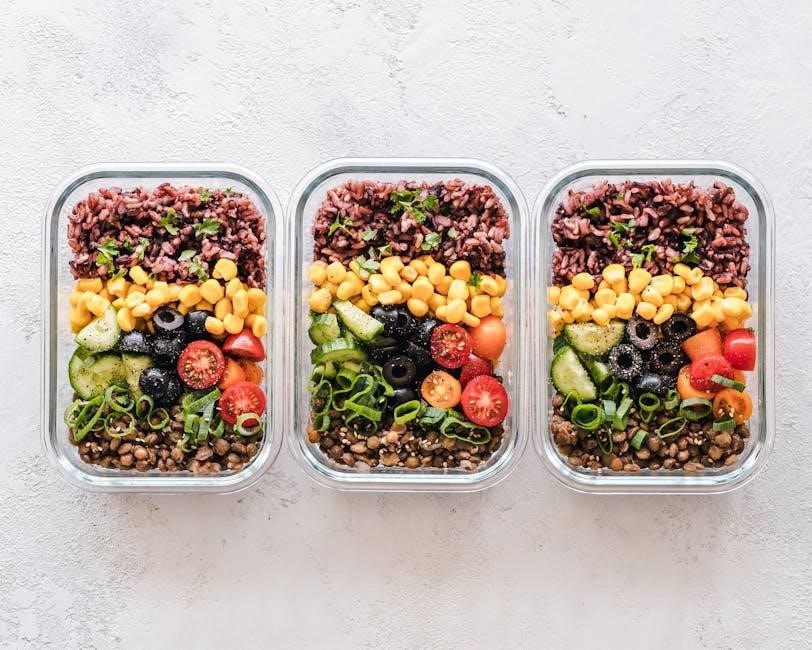Welcome to the comprehensive guide for Sanyo rice cooker instructions. This guide helps you master your appliance, ensuring perfect results every time. Learn proper techniques, explore advanced features, and maintain your cooker for long-lasting performance.
Discover how to unlock your Sanyo rice cooker’s full potential with easy-to-follow steps and expert tips. Whether you’re a beginner or an experienced user, this guide will enhance your cooking experience.
Importance of Proper Usage
Proper usage of your Sanyo rice cooker ensures safe, efficient, and consistent cooking results. Following the instructions helps prevent electrical hazards, burns, and damage to the appliance. Correct measuring, rinsing, and cooking techniques guarantee perfectly cooked rice every time, avoiding undercooking or overcooking.
Additionally, proper usage extends the lifespan of the cooker. Cleaning and maintaining the inner pot, lid, and control panel prevents residue buildup and ensures optimal performance. Adhering to guidelines also safeguards against overheating and electrical malfunctions, ensuring your rice cooker remains a reliable kitchen companion for years.
Benefits of Using a Sanyo Rice Cooker
A Sanyo rice cooker simplifies the cooking process, ensuring perfectly cooked rice every time. Its advanced features, like automatic cooking and keep-warm functions, make it a convenient addition to any kitchen. The cooker eliminates guesswork, delivering consistent results for various rice types and recipes.

With multiple cooking settings and a non-stick inner pot, it offers versatility for different dishes. The cooker also promotes energy efficiency and safety, making it a practical and reliable choice for home use. Its user-friendly design ensures easy operation, catering to both beginners and experienced cooks.
Key Features of Sanyo Rice Cookers
Sanyo rice cookers feature automatic cooking, keep-warm functionality, multiple preset settings, a durable non-stick inner pot, and an intuitive digital control panel for seamless operation and versatility.
Automatic Cooking Function
The automatic cooking function of Sanyo rice cookers ensures precise temperature control, effortlessly switching from cooking to warming once your rice is perfectly cooked. This feature eliminates the need for constant monitoring, allowing you to prepare flawless rice with minimal effort. The cooker detects when the rice is done, automatically transitioning to the keep-warm mode to maintain the optimal temperature. This advanced technology guarantees consistent results, whether you’re making white, brown, or specialty rice, making it a standout feature for home cooks and professionals alike.
Keep-Warm Function
The keep-warm function on Sanyo rice cookers ensures your rice stays perfectly warm and ready to serve for hours after cooking. Once the rice is cooked, the cooker automatically switches to this mode, maintaining an ideal temperature without overcooking; This feature is especially convenient for busy households, as it allows you to serve rice at your leisure. The keep-warm light illuminates when active, providing clear feedback. This function preserves moisture and flavor, keeping your rice fresh and delicious until you’re ready to enjoy it.
Multiple Cooking Settings
Sanyo rice cookers offer multiple cooking settings to cater to various rice types and preferences. These include settings for white rice, brown rice, porridge, and quick cooking. Advanced models feature specialized modes like sushi rice and steam cooking. The digital control panel allows easy selection of these options, ensuring precise cooking results. Some models also include a delay timer, enabling you to cook rice according to your schedule. These versatile settings make Sanyo rice cookers ideal for diverse culinary needs, providing flexibility and convenience for home cooks and professionals alike.
Non-Stick Inner Pot
The Sanyo rice cooker features a durable non-stick inner pot designed for easy food release and effortless cleaning. This coating prevents rice from sticking, reducing the risk of burnt or unevenly cooked grains. The non-stick surface also makes post-cooking cleanup simple, as residue doesn’t adhere strongly. Additionally, the inner pot is dishwasher-safe, further enhancing convenience. This feature ensures that your rice cooker remains in excellent condition while consistently delivering perfectly cooked rice with minimal effort required for maintenance and upkeep.
Digital Control Panel
The Sanyo rice cooker is equipped with an intuitive digital control panel, offering a user-friendly interface for seamless operation. This panel allows you to navigate various cooking settings, delay timers, and specialized modes with ease. Clearly labeled buttons and an LCD display ensure that you can monitor and adjust cooking parameters effortlessly. The digital control panel streamlines the cooking process, making it simple to achieve perfectly cooked rice every time. Its modern design complements any kitchen, while its functionality enhances your overall cooking experience with precision and convenience.

Understanding Sanyo Rice Cooker Parts
The Sanyo rice cooker consists of key components like the inner pot, outer pot, lid, steam vent, and control panel, each designed for specific functions to ensure optimal cooking performance.
Inner Pot
The inner pot is a core component of the Sanyo rice cooker, designed for direct cooking. Made of durable, non-stick material, it ensures rice cooks evenly without sticking. Rinse rice directly in the pot for convenience. After use, clean with mild soap and avoid abrasive scrubbers to maintain its non-stick surface. The inner pot is detachable, making it easy to serve and clean. Proper care extends its lifespan and ensures consistent cooking results. Always follow the manual’s guidelines for cleaning and maintenance to keep the inner pot in optimal condition for years of reliable use.
Outer Pot
The outer pot of your Sanyo rice cooker houses the inner pot and contains the heating element and electronic controls. It is designed to be durable and user-friendly. Regularly clean the exterior with a damp cloth to maintain its appearance. Avoid using harsh chemicals or abrasive cleaners, as they may damage the finish. The outer pot should not be submerged in water, as it contains electrical components. Proper care ensures the cooker operates efficiently and safely for years. Follow the manual’s guidelines for cleaning and maintenance to preserve its functionality and extend its lifespan.
Lid and Steam Vent
The lid and steam vent are essential components of your Sanyo rice cooker, designed to trap moisture and flavor during cooking. The lid should be cleaned regularly to prevent residue buildup. Use a soft cloth and mild detergent, avoiding harsh chemicals. The steam vent ensures proper ventilation and pressure release. After each use, check the vent for blockages and clean it gently to maintain optimal performance. Never submerge the lid or steam vent in water, as they may contain electrical parts. Proper maintenance of these parts ensures efficient cooking and longevity of your rice cooker.
Control Panel
The control panel is the central interface for operating your Sanyo rice cooker. It features buttons and digital displays for selecting cooking modes, setting timers, and monitoring progress. Use the buttons to choose between options like white rice, brown rice, sushi, or porridge. The delay timer allows you to schedule cooking up to 24 hours in advance. Regularly wipe the control panel with a soft, damp cloth to keep it clean and functional. Avoid using harsh chemicals or abrasive materials, as they may damage the surface. Proper care ensures smooth operation and longevity of your rice cooker.

Basic Cooking Instructions
Start by measuring rice and water, then rinse the rice thoroughly. Add both to the inner pot, select your desired setting on the control panel, and begin cooking.
Measuring Rice and Water
Accurately measure rice using the provided cup (1 cup = 180 ml) and water according to the manual. For optimal results, use a 1:1.2 to 1:1.5 rice-to-water ratio. Add both to the inner pot, ensuring the water level aligns with the marked guidelines. For precise measurements, use the measuring cup included with your Sanyo rice cooker. Avoid overfilling, as this may cause overflow during cooking. If desired, add optional ingredients like salt or seasonings before starting. Always refer to your specific model’s manual for exact ratios and guidelines.
Rinsing Rice
Rinsing rice before cooking is essential to remove excess starch and impurities, ensuring better texture and flavor. Use the inner pot to rinse rice under cold water, swishing gently with your hands. Continue until the water runs clear or becomes significantly less cloudy. This step helps reduce stickiness and improves cook results. For optimal performance, avoid skipping this process. After rinsing, drain thoroughly and proceed with cooking. Note: Some models may include specific rinsing guidelines in their manuals, so refer to your Sanyo rice cooker’s instructions for additional tips.
Adding Rice and Water to the Inner Pot
After rinsing, add the measured rice to the inner pot. Use the provided measuring cup to ensure accurate portions. Fill the inner pot with water according to the marked level corresponding to the rice amount. The general ratio is 1 cup of rice to 1.2 cups of water. Align the water level with the guideline on the inner pot for precise measurement. Gently stir to distribute evenly. Avoid overfilling to prevent overflow during cooking. Ensure the inner pot is properly placed in the outer pot before proceeding. Follow the manual for specific water levels tailored to your Sanyo model.
Using the Control Panel
The control panel simplifies cooking with intuitive buttons for selecting modes and timers. Press the “Start/Cancel” button to begin or halt cooking. Use the “Delay Timer” to schedule cooking up to 24 hours in advance. Choose from preset modes like “White Rice,” “Brown Rice,” or “Quick Cooking” based on your preference. The digital display shows the selected settings and progress. Adjust the timer or mode as needed before starting. Always refer to your specific model’s manual for detailed button functions and customization options to optimize your cooking experience.
Starting the Cooking Process
Once the rice and water are in the inner pot, ensure it is securely placed inside the cooker. Close the lid firmly to trap steam. Select the desired cooking mode using the control panel, such as “White Rice” or “Brown Rice.” Press the “Start” button to initiate cooking. The cooker will automatically adjust heat and timing based on the selected mode. A beep or light will signal completion. Allow the cooker to switch to “Keep Warm” mode, then wait a few minutes before opening to ensure fluffy results. Always follow the sequence outlined in your specific model’s manual for consistent outcomes.
Handling Completion
Once the rice cooker signals completion with a beep or light, allow it to switch to “Keep Warm” mode. Wait a few minutes before opening to ensure the rice is fluffy. Carefully open the lid using the provided spatula to prevent scratching the non-stick pot. Gently fluff the rice with the spatula for even texture. Unplug the cooker to avoid overheating. Let it cool slightly before cleaning. Always handle the inner pot with care to prevent burns and maintain your cooker’s longevity. Refer to your model’s manual for specific post-cooking instructions.

Advanced Settings and Functions
Explore advanced settings and functions for precise control. Customize cooking with specialized modes, delay timers, and smart sensors for perfect results effortlessly every time.
Specialized Cooking Modes
Sanyo rice cookers offer specialized cooking modes for diverse culinary needs. From white rice to brown rice, sushi, and porridge, these modes ensure optimal results. Advanced models feature micro-computerized technology to adjust temperature and cooking time automatically, catering to different grain types and recipes.
Additional modes include settings for multi-grain rice, quick cooking, and steam functions. These modes enhance versatility, allowing users to prepare a variety of dishes beyond traditional rice. The intuitive interface makes it easy to select the perfect mode for any meal, ensuring flavorful and perfectly cooked dishes every time.
Delay Timer
The delay timer function on Sanyo rice cookers allows you to set a cooking start time up to 24 hours in advance. This feature offers convenience, enabling you to prepare ingredients and schedule cooking to align with your meal plans. Simply add rice and water, select the desired delay, and the cooker will automatically begin the process at the set time, ensuring perfectly cooked rice when you’re ready.
This function is ideal for busy households, as it saves time and effort. Combine it with specialized cooking modes for enhanced flexibility and ease in meal preparation. The delay timer ensures your rice is cooked to perfection, hot and ready when you need it.

Maintenance and Cleaning
Regular cleaning and maintenance ensure optimal performance and longevity of your Sanyo rice cooker. Clean the inner pot, outer pot, and accessories after each use. Descale periodically to prevent mineral buildup and store the cooker properly when not in use.
Cleaning the Inner Pot
Cleaning the inner pot of your Sanyo rice cooker is essential for maintaining hygiene and performance. After each use, rinse the pot with warm water and mild dish soap, using a soft sponge or cloth to avoid scratching the non-stick surface. For stubborn food residue, soak the pot in warm, soapy water for about 30 minutes before scrubbing gently. Avoid using abrasive cleaners or scourers, as they may damage the coating. Rinse thoroughly and dry with a soft cloth to prevent water spots. Regular cleaning ensures optimal cooking results and extends the lifespan of your rice cooker.
Cleaning the Outer Pot
Cleaning the outer pot of your Sanyo rice cooker is a straightforward process that helps maintain its appearance and functionality. Start by unplugging the appliance for safety. Use a soft, damp cloth to wipe down the exterior, removing any dust or splatters. For tougher stains, mix a small amount of mild dish soap with warm water and gently scrub the area with a non-abrasive sponge. Avoid harsh chemicals or scouring pads to prevent damage to the finish. Rinse the cloth thoroughly and wipe away any soap residue. For stubborn spots, a diluted solution of white vinegar can be effective. Finally, dry the outer pot with a soft cloth to prevent water spots and maintain its shine.
Descaling the Rice Cooker
Descaling your Sanyo rice cooker is essential to remove mineral deposits from water that can affect performance. Mix equal parts water and white vinegar in the inner pot. Turn on the cooker using the porridge setting to heat the solution. Allow it to soak for about an hour to loosen scale buildup. Scrub gently with a non-abrasive sponge or brush, focusing on areas with heavy deposits. Rinse thoroughly with clean water to remove any vinegar residue. Repeat if necessary for stubborn scaling. Regular descaling ensures optimal heating and longevity of your rice cooker. Always refer to your specific model’s manual for additional tips.
Storing the Rice Cooker
Proper storage of your Sanyo rice cooker ensures longevity and maintains its performance. After cleaning, dry the cooker thoroughly, including the inner pot and lid, to prevent moisture buildup. Store the cooker in a cool, dry place, away from direct sunlight and heat sources. If storing for an extended period, place the components in the original packaging or a protective cover to avoid dust accumulation. Ensure all parts are completely dry to prevent mold or mildew. For additional protection, consider storing the inner pot separately. Always refer to your user manual for specific storage recommendations tailored to your model.

Safety Precautions
Always handle hot surfaces with care, using oven mitts or handles. Avoid touching the lid and sides during operation. Keep children away from the cooker to prevent accidents. Ensure the appliance is placed on a stable, heat-resistant surface. Never submerge the cooker in water or expose it to excessive moisture. Follow all instructions carefully to avoid electrical hazards and ensure safe operation. Regular maintenance and proper storage are essential for longevity and safety.
General Safety Tips
Always read the manual before first use to understand proper operation. Keep the rice cooker away from children and ensure it is placed on a stable, heat-resistant surface. Avoid touching hot surfaces, such as the lid or sides, during cooking. Use the handles provided to lift or move the cooker. Never submerge the cooker in water or expose it to excessive moisture. Ensure the power cord is securely plugged into a nearby outlet and avoid overloading the appliance. Regularly inspect the cooker for damage and ensure all parts are in good condition before use.
Additionally, unplug the rice cooker when not in use or during cleaning. Always follow the manufacturer’s guidelines for cooking ratios and settings to prevent overcooking or overheating. Proper maintenance and storage are crucial for safe and efficient performance. By adhering to these safety tips, you can enjoy safe and optimal use of your Sanyo rice cooker.
Handling Hot Surfaces
Always exercise caution when handling hot surfaces of your Sanyo rice cooker. The lid, inner pot, and outer body can become extremely hot during and after cooking. Avoid touching these surfaces directly with your hands. Use oven mitts or the provided handles to lift or move the cooker. Keep children away from the appliance while it is in operation. Allow the cooker to cool down for at least 30 minutes before cleaning or storing. Never use wet hands or utensils near hot surfaces, as this could cause burns or electrical issues. Proper handling ensures safe and enjoyable use of your rice cooker.

Troubleshooting Common Issues
Resolve common issues like the rice cooker not turning on, overcooking, or rice sticking to the pot with practical solutions and expert guidance for optimal performance.
Rice Cooker Not Turning On
If your Sanyo rice cooker isn’t turning on, check the power cord to ensure it’s properly plugged into a functioning outlet. Verify the rice and water measurements match the manual’s guidelines. If the issue persists, inspect for blown fuses or tripped circuit breakers. Ensure the lid is securely closed, as some models require it to operate. If none of these steps resolve the problem, consult the user manual or contact customer support for further assistance. Always follow safety guidelines when troubleshooting electrical appliances.
Overcooking or Undercooking
Overcooking or undercooking rice can occur due to incorrect water measurements or improper rice-to-water ratios. Always use the provided measuring cup for accuracy. Ensure the inner pot is clean and free of residue. If rice is undercooked, add a small amount of water and restart the cooking process. For overcooked rice, reduce water in future attempts. Adjusting settings like cooking modes or delay timers can also help achieve desired results. Refer to your Sanyo rice cooker manual for specific guidelines on different rice types and settings to ensure perfectly cooked rice every time.
Rice Sticking to the Pot

Rice sticking to the pot can occur due to insufficient water, improper rinsing, or not cleaning the inner pot thoroughly. To prevent this, rinse rice before cooking to remove excess starch. Use the correct water-to-rice ratio as specified in the manual. Ensure the inner pot is clean and free of residue before adding rice and water. If rice still sticks, lightly oil the inner pot or adjust the water level slightly. Regular cleaning and maintenance of the non-stick coating will help prevent sticking and ensure optimal performance. Refer to your Sanyo rice cooker manual for specific care instructions.

Accessories and Additional Features
Sanyo rice cookers come with a measuring cup and spatula, ensuring precise measurements and easy serving. These accessories enhance your cooking experience and maintain optimal performance.
Measuring Cup
The measuring cup provided with your Sanyo rice cooker is essential for accurate rice and water measurements. It ensures the perfect rice-to-water ratio, which is crucial for evenly cooked rice. The cup is designed to match the cooker’s capacity, making it easy to measure the right amount every time. Proper use of the measuring cup helps avoid common issues like undercooked or overcooked rice. Always refer to the manual for specific measurements, as the cup’s capacity may vary depending on the model. This accessory is a key component for achieving consistent results.
Spatula
The spatula included with your Sanyo rice cooker is a vital accessory for serving and handling cooked rice. Designed to be heat-resistant and gentle on the non-stick inner pot, it helps prevent scratching and ensures easy portioning. Use the spatula to fluff and mix rice after cooking for even texture. It’s also ideal for scooping rice without sticking or breaking grains. Regularly clean the spatula to maintain hygiene. This tool is essential for serving perfectly cooked rice and extends the lifespan of your cooker’s inner pot by preventing damage during food handling.
Mastering your Sanyo rice cooker is simple with these instructions. Follow the guidelines to unlock its full potential and enjoy perfectly cooked rice every time, effortlessly.
Final Tips for Optimal Use
For the best results, always measure rice and water accurately using the provided cup. Rinse rice thoroughly before cooking to remove excess starch. Use the correct water ratio for different rice types. Avoid overfilling the inner pot to prevent overflow. Clean the cooker regularly, especially the inner pot and steam vent, to maintain hygiene and performance. Store the cooker in a dry place when not in use. Experiment with advanced settings for varied recipes, and refer to the manual for troubleshooting common issues. Proper care ensures longevity and consistent cooking results.

